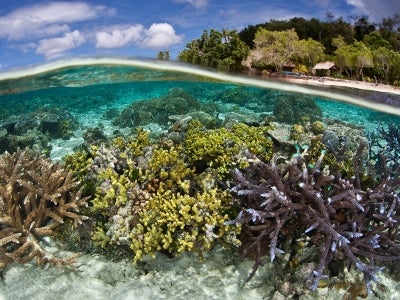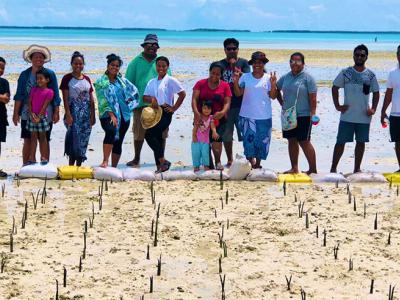

Contributed by Sara Baptiste-Brown, Environment and Conservation Division (MELAD)
In the picture: President Anote Tong planting mangroves during UN Secretary General Ban Ki-Moon visit, September 5th
With the ratio of land to total area at 1:4375, Kiribati’s 800km2 of land represents a small proportion of its Exclusive Economic Zone. But don’t let the numbers fool you, land management is of prime importance in Kiribati. The sustainability of natural resources, the physical land, and ultimately the people are all at stake. This is the context in which the Sustainable Land Management Programme is operating in Kiribati.
The GEF-UNDP Targeted Portfolio Project on Capacity Building and Mainstreaming of Sustainable Land Management (SLM) for Least Developed Countries (LDCs) and Small Island Developing States (SIDS) has lofty goals. It is addressing the mainstreaming of land degradation issues into national legal frameworks while ensuring that governments can continue to promote economic growth and development in their countries (more information on UNDP Asian-Pacific Regional Centre).
Since 2009, the SLM activities represent a concerted effort to respond to the main barriers (planning, legal frameworks, research) identified in Capacity Building for Sustainable Land Management in Kiribati. The activitiesspan a broad array of issues such as: Integrated Land-Use Planning, Research in SLM, Resource Survey, Baseline Data, Sustainable Agriculture, Land Rehabilitation, SLM into national strategies, SLM into sector policies, Policy/options for Beach Mining, Gender Promotion (For more information visit the website Secretariat of the Pacific Region Environment programme)
A resounding trend throughout all activities is the involvement other departments and relevant communities. A variety of training sessions, workshops, and consultations have utilized radio, schools, communities and councils to include many voices in planning for the future. These interventions cover topics like strategy and policy development incorporating SLM principles, awareness training on urban planning and new settlements, monitoring and enforcement, land-use, aggregates management, and gender mainstreaming.
From a capacity development standpoint, demonstration projects were initiated to provide examples of waste management, composting, and sustainable agro-forestry in water catchments. Training sessions were completed on organic waste, organic agriculture, software for urban planning, GIS, GPS, urban planning design, data collection and analysis, and land information management.
There has also been a great push to incorporate sustainable land management into the national legal framework. Many policies have been drafted and are awaiting endorsement by the Cabinet; these include urban planning, sustainable use and management of aggregates, and agriculture policies that align with the Kiribati Development Plan and the National Action Programme (NAP).
The SLM Programme unit has also recognized the need to gather more information about the current situation through a needs-assessment for science and socio-economic research was conducted to determine priorities for training, market studies on organic produce in several areas, and water quality testing in water catchments.
Some more examples of implemented actions include a pigpen that incorporates waste management in organic farming, and the design of a water catchment facility. Following-up on the training on data collection and analysis a baseline assessment on land degradation is ongoing through daily patrols.
Although a lot of progress has been achieved, challenges remain. Most notably community interest and participation, and information sharing about lessons learnt, narratives, and reports on land degradation issues need to be strengthened.
Featured Event ReportThe agro-forestry demonstration project was implemented on nine islands from the Gilbert group in 2010 as a community-based activity, with both men and women participants from different villages. Various legumes including tomato, cucumber, and cabbage were planted because of their nutritious qualities for consumption, and also because they improve soil quality composition. Composting was also introduced to complement soil enrichment practices. Nitrogen fixing trees were planted on the perimeter of the crop area to improve long-term survivability. This project incorporated inventories of existing plants on islands to gain information about native varieties. Awareness building was also a part of the process, to ensure that agricultural tools were being used appropriately among villagers. The events proved to be educational for the communities but also for the SLM team. One good example was the fact that the communities did not immediately understand that the legumes were consumable, and as such were allowing them to enrich the soil and then uprooting and throwing them away. Remedial training and awareness-building was conducted to counter this practice and the SLM team now has a better understanding of the knowledge gaps to be addressed. |
 agroforestry-kiribati.png
|


